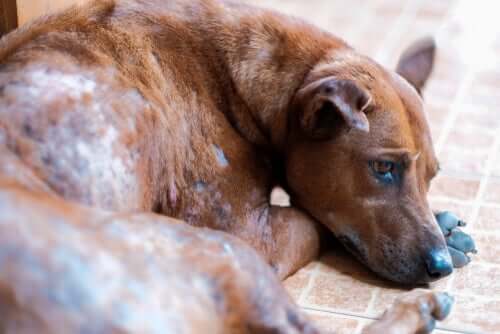Puppies With Scabies: Causes and Symptoms

Scabies is a group of diseases that mites that feed on the skin can transmit. In general, this disease is highly contagious and causes very strong itching in the people or animals that suffer from it. Do you want to know about how puppies with scabies can be treated? Stick with us and learn more in this article!
Types of scabies
There are different kinds of scabies, depending on the species of mite responsible for it. The following briefly describes the types of scabies:
Otodectic Scabies
Produced by the Otodectes Cynotis mite, people also call this kind of scabies “ear scabies”. This type of scabies is more common in cats than in dogs. When found in dogs, it usually comes from places such as kennels or stores with poor hygiene.
Sarcoptic mange
This disease is one of the itchiest ones. The responsible mite belongs to the Sarcoptes genus. Although it can affect virtually all mammal species, it’s more frequent to find it in dogs.
Cheyletiellosis
The culprit for this one is a parasite belonging to the Cheyletiella Yasguri species. This microscopic mite has a characteristically reddish color and can easily spread between dogs and cats. The positive side is that the treatment is rather simple and it can usually be eliminated without further complications.
Demodectic mange
Vets also call it Demodex, and the culprit is a mite that is a common tenant in a dog’s skin. However, it can also be found on cats’ skin. In addition, its transmission process is very specific and will be discussed below.
Demodectic mange and its carrier
Mites belonging to the Demodex genus are the transmitters of this disease and, as we’ve already mentioned, cases of demodectic mange have been observed in both dogs and cats.
Is it contagious?
Experts don’t consider this disease to be contagious. It’s a self-limiting disease found in puppies. Once the puppy grows up, its body develops immunity to mites and it no longer shows any symptoms of scabies.
In addition, it’s not common that the mites can spread to other pets in the household, as long as the pet is not immunodeficient. Moreover, this kind of scabies doesn’t affect humans while other types of scabies do, such as Sarcoptic scabies.
Causes
This disease has a very particular way of transmitting itself to another being. Mother dogs transmit this microscopic mite to their puppies after birth, especially during the breastfeeding period.
This mite is usually located on a dog’s skin and, more often than not, it doesn’t cause any trouble. However, the disease occurs when the mite begins to multiply and is out of control.
The increase of the appearing mites causes the destruction of the dog’s hair roots. It also causes strong itching.

Scabies tends to manifest in puppies of under 18 months of age. However, it’s also common for it to be present in adult dogs that often have a weakened immune system.
Symptoms
This disease causes intense itching. However, the itching may or may not occur in this type of scabies.
Usually, damage begins in areas of fine hair, such as the eye or mouth area. In addition, some patches of hair on the limbs or torso may also be lost.
The disease can be focal or widespread. If it’s the widespread case, animals lose quite extensive patches of hair on different parts of the body.
Other notable symptoms are reddish and scaly looking skin in hairless areas and also a bad smell. On the other hand, the development of secondary infections causes pain, while flaking and bald spots become evident as the disease gradually advances.

Treatment for puppies with scabies
When the doctor has carried out all the appropriate tests, such as the mite search, a diagnosis is confirmed. After this is done, the vet will prescribe the most appropriate medication for each case. However, depending on whether the disease’s extension has been focal or widespread, different actions will be taken:
Focal scabies
In this case, the issue resolves itself after a few weeks or a couple of months. The puppy develops resistance against the mite and the clinical symptoms disappear. Therefore, no treatment is necessary whatsoever.
Widespread scabies
On the other hand, if scabies is widespread, one must act differently. Treatment may vary depending on the type of medication prescribed by the veterinarian doctor.
Medications may be administered directly to the skin or orally. As a first step, this medication can be prescribed in the form of an ointment.
The kind of treatment will be decided by the vet. However, it should be mentioned that this therapy involves a process of several months. Moreover, it’s a long process because when the mites are no longer found on the skin, the treatment shall continue for another month. This is done in a preventive manner.
To sum it up
The disease isn’t contagious. The main victims of this disease are puppies, but this condition has also been observed in cats.
We hope you found this article useful! See you next time.
All cited sources were thoroughly reviewed by our team to ensure their quality, reliability, currency, and validity. The bibliography of this article was considered reliable and of academic or scientific accuracy.
-
Vetlearn. La Sarna Demodéctica. 2013;2. [Internet]. Disponible en: http://vetfolio-vetstreet.s3.amazonaws.com/28/536100a2a611e2b140005056ad4734/file/Gu%C3%ADaDeCuidado_SarnaDemod%C3%A9ctica.pdf
-
SARNA EN PERROS [Internet]. Purina® PRO PLAN®. [citado 21 de agosto de 2019]. Disponible en: /consejos/sarna-perros.html